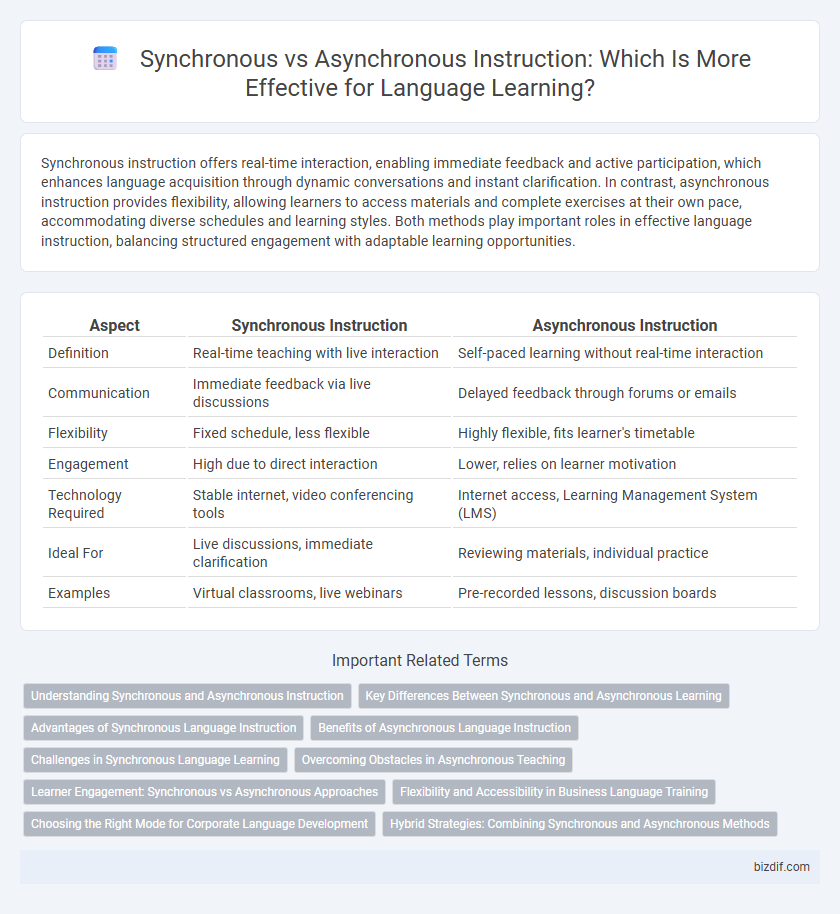Synchronous instruction offers real-time interaction, enabling immediate feedback and active participation, which enhances language acquisition through dynamic conversations and instant clarification. In contrast, asynchronous instruction provides flexibility, allowing learners to access materials and complete exercises at their own pace, accommodating diverse schedules and learning styles. Both methods play important roles in effective language instruction, balancing structured engagement with adaptable learning opportunities.
Table of Comparison
| Aspect | Synchronous Instruction | Asynchronous Instruction |
|---|---|---|
| Definition | Real-time teaching with live interaction | Self-paced learning without real-time interaction |
| Communication | Immediate feedback via live discussions | Delayed feedback through forums or emails |
| Flexibility | Fixed schedule, less flexible | Highly flexible, fits learner's timetable |
| Engagement | High due to direct interaction | Lower, relies on learner motivation |
| Technology Required | Stable internet, video conferencing tools | Internet access, Learning Management System (LMS) |
| Ideal For | Live discussions, immediate clarification | Reviewing materials, individual practice |
| Examples | Virtual classrooms, live webinars | Pre-recorded lessons, discussion boards |
Understanding Synchronous and Asynchronous Instruction
Synchronous instruction involves real-time interaction between instructors and learners, allowing immediate feedback and collaborative engagement through live video or chat sessions. Asynchronous instruction provides flexibility by enabling learners to access course materials, complete assignments, and participate in discussions on their own schedules without real-time interaction. Understanding these instructional modes helps educators design effective language learning experiences that balance interaction and flexibility to meet diverse student needs.
Key Differences Between Synchronous and Asynchronous Learning
Synchronous instruction requires learners and instructors to engage simultaneously, fostering real-time interaction and immediate feedback essential for collaborative activities. Asynchronous instruction allows learners to access materials and complete tasks at their own pace, providing flexibility and accommodating diverse schedules. Key differences include the timing of interaction, with synchronous emphasizing live participation and asynchronous prioritizing self-directed learning.
Advantages of Synchronous Language Instruction
Synchronous language instruction enhances real-time interaction, enabling immediate feedback and clarification, which accelerates language acquisition. It fosters a collaborative learning environment through live discussions and peer engagement, improving speaking and listening skills. This format also maintains structured schedules, promoting consistent practice and motivation among learners.
Benefits of Asynchronous Language Instruction
Asynchronous language instruction offers flexible scheduling, allowing learners to access materials and complete exercises at their own pace, which enhances retention and reduces stress. It supports diverse learning styles through varied multimedia content such as videos, podcasts, and interactive quizzes, improving engagement and comprehension. This mode of instruction also facilitates repeated practice and review, crucial for mastering complex language skills like grammar and pronunciation.
Challenges in Synchronous Language Learning
Synchronous language learning often faces challenges such as limited flexibility, as learners must adhere to fixed schedules that may not accommodate diverse time zones or personal commitments. Technical issues like unstable internet connections can disrupt real-time communication, hindering interactive speaking and listening practice essential for language acquisition. The lack of self-paced review opportunities may reduce learner autonomy, impacting the absorption and retention of complex linguistic structures.
Overcoming Obstacles in Asynchronous Teaching
Overcoming obstacles in asynchronous instruction involves leveraging tools like discussion forums, video feedback, and adaptive learning platforms that provide timely, personalized support to learners. Effective strategies include setting clear expectations, creating structured modules, and using frequent formative assessments to maintain student engagement and accountability. Incorporating multimedia resources and peer collaboration opportunities enhances comprehension and motivation despite the lack of real-time interaction.
Learner Engagement: Synchronous vs Asynchronous Approaches
Synchronous instruction fosters real-time interaction, enhancing learner engagement through immediate feedback and dynamic discussions. Asynchronous instruction allows learners to engage with materials at their own pace, promoting reflection and self-directed study. Combining both approaches can optimize engagement by balancing interaction with flexibility.
Flexibility and Accessibility in Business Language Training
Synchronous instruction in business language training offers real-time interaction, enhancing immediate feedback and engagement but limits flexibility due to fixed schedules. Asynchronous instruction provides greater accessibility and self-paced learning, allowing professionals to balance training with demanding work commitments. Combining both methods optimizes flexibility and accessibility, catering to diverse learner needs in corporate environments.
Choosing the Right Mode for Corporate Language Development
Synchronous instruction offers real-time interaction, fostering immediate feedback and enhanced engagement crucial for corporate language development. Asynchronous instruction provides flexibility, enabling learners to access materials at their own pace, which supports diverse schedules and self-directed learning. Selecting the optimal mode depends on organizational goals, employee availability, and the desired balance between interaction and autonomy in language skill acquisition.
Hybrid Strategies: Combining Synchronous and Asynchronous Methods
Hybrid strategies in language instruction effectively blend synchronous and asynchronous methods to enhance learner engagement and flexibility. Real-time video sessions facilitate immediate interaction and feedback, while asynchronous materials like recorded lectures and discussion forums allow learners to review content at their own pace. This combination maximizes accessibility and supports diverse learning styles, leading to improved comprehension and language acquisition.
Synchronous Instruction vs Asynchronous Instruction Infographic

 bizdif.com
bizdif.com